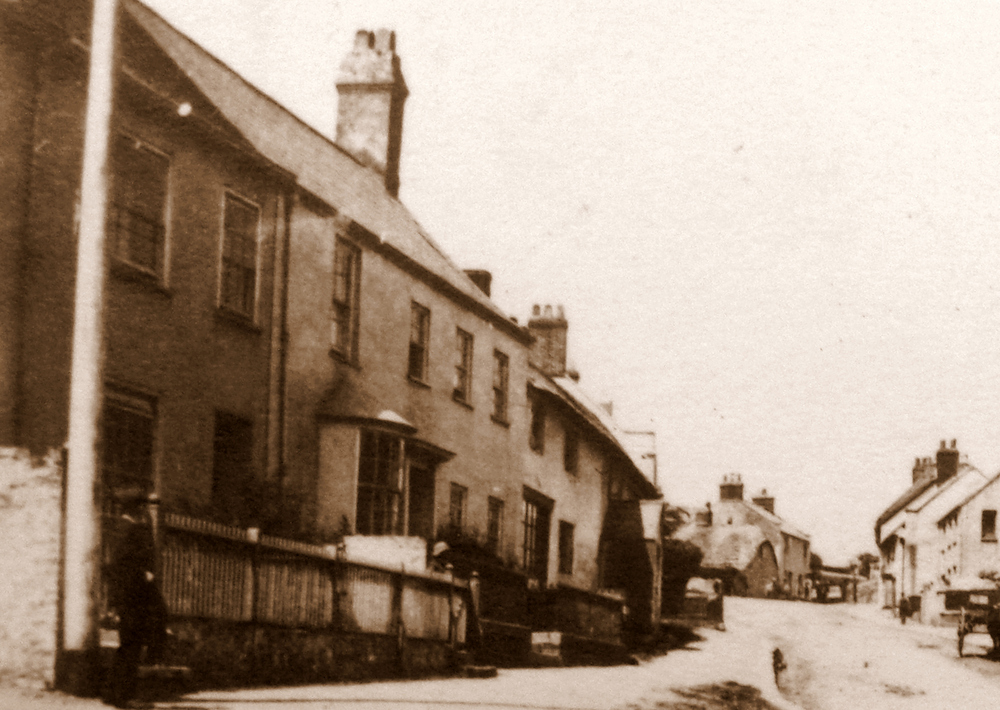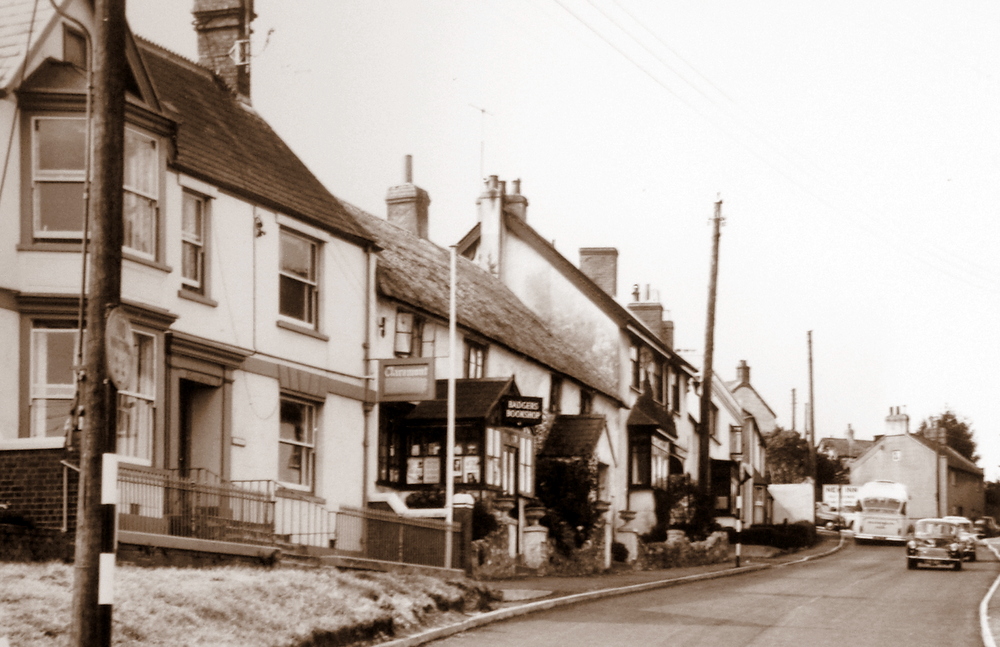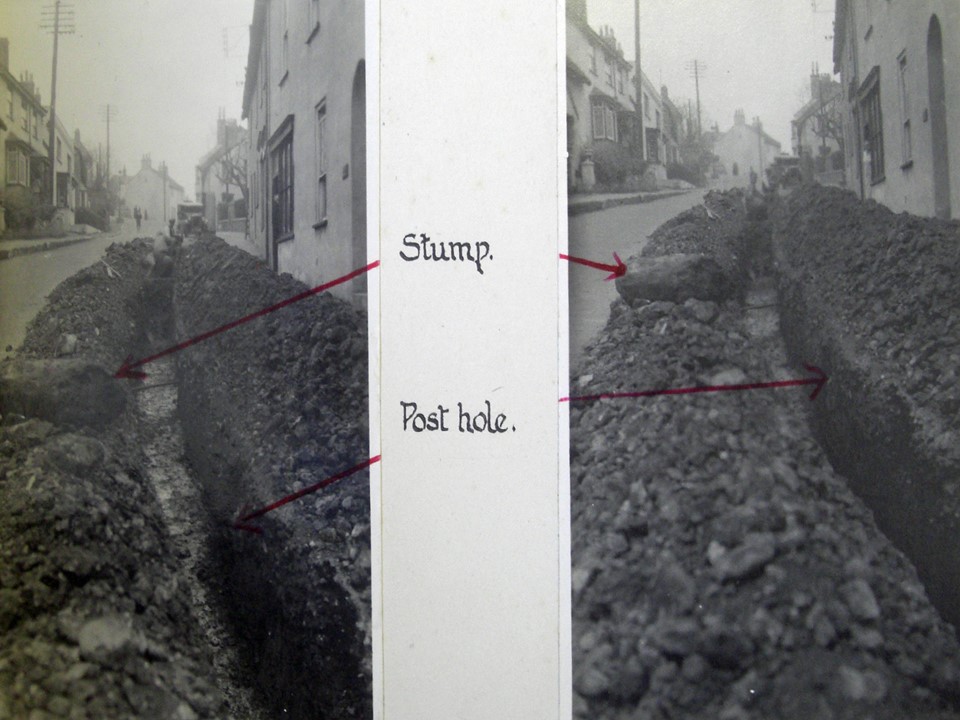 |
Claremont. The Street Charmouth |
 |
|
|
At the junction of Higher Sea Lane and the Street is a large gabled house now called Claremont. It has not always looked like that or known by that name. This article will shed some light on its early history and those people who were to call it their home for many centuries. For the building you see now is a fine Georgian house that was remodelled at the end of the 19th century as was the fate of many other properties in the village. Early photographs reveal how it once appeared on The Street with a curious curved window jutting out into its garden. It’s five bay frontage had been altered by this addition and a larger window had been inserted on the next level replacing two earlier windows. It had once been where a Toll Road keeper had sat waiting for the many coaches that were passing through Charmouth between Exeter and London. The stumps of the original wooden gate that would have straddled the Street were found in 1937 whilst laying sewage pipe. The original Turnpike Road that passed through Charmouth was built in 1756 and the toll office may well go back to the time it was opened. It was no doubt superseded in 1824 when a new one was built in brick at the bottom of the street pass the river bridge, which is still standing today.
With the assistance of the many resources that exist today I have been able to trace the history of Claremont, which is a name bestowed on it after the First World War
when it became a Guest House. Before that it was known as "Knapp House", which is now confusing as a house of this name is nearby. The earliest record I have found so far of that name is in 1832 when Mrs Susannah Welch was living there. From this I was able to trace the ownership back to 1754 through the earlier Poor Rate and Land Tax lists that have survived for Charmouth.
Although the original house was built in the mid-18th century by William Gray, the site it stands on goes back much further in history. It would have originally been owned by the Monks of Forde Abbey in the Middle Ages. After the reformation in 1539 it was bought by Sir William Petre, whose son John was to sell the village off to various land owners in 1575 on 2000 year leases. The bulk of the holdings were bought by William Pole of Shute, near Axminster, although others had the opportunity to purchase the remainder. The main buyer was Edward Limbry, whose family formerly rented from the Manor. Amongst these sites were Yandover (Little Lodge), Manns (The Elms) and Fountains ( Charmouth House). In 1588 he was assessed for an income of £48 per year, a considerable amount for those times. The estate is developed by his offspring and the Will for Edward, his grandson for 1645 shows that his son Andrew was living in the east part of what is today Charmouth House and his other son William in the west part. He leaves most of his estate to Andrew who in a later Will of 1692 leaves it in turn to his daughter Mary and her son, William.
Charmouth House was formerly called The Fountain Inn and with a number of fields totalling over 40 acres that was later referred to as Foxley Farm and stretched back from the Street as far as Old Lyme Hill.
The deeds to Charmouth House have survived back to 1708 which describe all the fields and their acreage. They reveal that it was Edward who had sold the property to Edward Lush of Chideock, who in turn had sold it to Robert Burridge, a famous Mariner from Lyme Regis. By 1753 it had been inherited by Francis Folaquier and Elizabeth nee` Burridge, his wife who sold it off in separate lots. Benjamin Bradford from Wootton Fitzpaine had Foxley Farm with its house (now Badgers) John Goring had The Fountain (now Charmouth House) and William Gray the land where Knapp House (Claremont) is.
William Gray is where the story of Claremont now begins. He was no doubt the gentleman who built the house we see today, and his descendants were to own it for nearly a century although not to live there for most of that time. He first appears in our records for the Poor Tax list of 1754 as “Mr William Gray for his Estates -£1-1-0”. This was towards the end of his life which had been spent in Limehouse in London. He had considerable property both there and in Suffolk. His extensive Will of 1762 provides us with an insight into his family of four children and various grandchildren. He was to provide a thousand pounds in trust as an annuity from the South Sea Fund, which ended when the Bubble burst. He writes:
“I William Grey late of Lime house in Middlesex, but now of Charmouth, in the county of Dorset, Gentleman, do make this my last Will. After the death of my wife all my messuages, Tenements, Several Closes of Land and hereditaments situated and lying within the parish of Charmouth to my eldest son, Bennett Gray”.
He in turn continues to live in London and rent Knapp House and other properties out. Again, it his Will of 1823 that provides us with information on this gentleman. He is described as a Haberdasher and Citizen of London who had other properties and a share in the ship “Porpus” as well as an estate in Kingston, Jamaica. He leaves these and his house in Limehouse to his sisters- Elizabeth Fellows, Mary Aust and Susannah Gray. It is Mary Aust who in turn is the owner of the Charmouth properties including Knapp House. Her Will shows her living in Mile End, Essex and it is to her nephew, Harry Smith that inherits her Estate. She is 88 when she dies in 1822 and is buried in St. Anne’s Church, Tower Hamlets in London.
Mrs Mary Aust is shown as benefitting from the Charmouth Estate in the Land Tax and Poor Rates lists from 1780 until her death in 1822. It is the village Rectors, William and later his son, Brian who are her executors for this. A list her various tenants and how much they are paying in tax reveals changes. In 1783 a map was produced for the Village, which has since been lost but the record book exists and shows the following with Knap House in bold:
99.Mrs Mary Aust, House & Orchard (£3-0-0d) 0a 1p 35r
100.Mrs Mary Aust, Late Grey`s House & Orchard (£6-0-0d) 0a 1p 36r
101.Mrs Mary Aust , Lambs Mead (£2-14-2d) 1a 2p 31r
102.Mrs Mary Aust, House & Orchard by the Mill (£2-10-0d) 0a 2p 38r
103 Mrs Mary Aust, House & Orchard opposite the Fountain Inn Garden(£2-10-0d) 0a 2p 26r
The house is rented to a number of wealthy tenants including the Reverend Joseph Good who is there from 1806 until his death in 1817. There is a fine marble memorial to him and his wife, Elizabeth in St. Andrews Church. After him came George Hart who lived there until his death in 1824 there, aged 88. Coincidentally this was the year that the estate came into the hands of Harry Smith, the nephew of Mary Aust. There is a considerable increase in the Poor Rates, signifying major changes or additions. These reveal that Jacob Baker is paying slightly less tax for his house and orchard. Matthew Lock 3d Tax for his new house and garden. Mr. Warner who has taken over the lease of Knapp House is paying 8d which is double what George Hart was paying the year before. This no doubt was the year that the adjoining properties now called Foxley Green and Foxley. were built and Claremont enlarged. He is only there briefly before his death and a Mr. Beaven is the next tenant in 1827. It is interesting as in that year Mathew Lock now becomes the agent for Mr Smith and his house is included with that of Knap house in the Poor Rates. The fact he was a builder may be of relevance as to who was working on Knap House and its neighbours at the time. The Poor Rates reveal a number of different people renting the houses and it is in 1830 that the name is recorded for the first time. By 1832 it is Bennett Fellows R.N. who is receiving the rents and he has a new tenant in Mrs. Susannah Welch. We know more about her than previous occupiers as her time coincides with the 1841 Census which is also the year a very detailed map is produced of the village which is full of information. The house and garden occupy just over an acre that time although Bennett Fellows owns 14 acres of surrounding fields behind it including where Five Acres is built on today. In his Will of 1842 he gives to “Mrs Margaret Smith now living with us the copyhold house and premises in the parish of Leyton in the county of Essex for her life the property in the village of Charmouth in the county of Dorset. I leave to her and at her disposal to whom she may please. This property has been in the family several ages. I request and hope Mrs Smith will at her death leave all to one person”
His tenant, Susannah Welch is a widow, aged 45 with three daughters, Eliza, aged 19, Susannah, aged 18 and Martha aged 16. There are also two servants - Marian Hodges and Sarah Lee living with them. She continues to live there until 1861 when Dr. Joseph Symes takes on the tenancy. He and his family are there for a number of years and his wife appears on the 1881 census aged 76 by then. There is a reference to their time in 1866 in the Dorset Chronicle “concerning a fashionable wedding held in the village which they were involved with. It mentions the wedding breakfast was at the residence of Joseph Symes, esq., Knapp House, from which the happy pair started on their wedding tour. The church bells rang throughout the day. The breakfast was most beautifully laid out, and the house was tastefully decorated”.
On Mrs. Symes death in 1885 the house was advertised as follows:” To be Let, furnished for summer months, a House containing dining and drawing rooms, five bed-rooms, including two attics, with lovely view or hills and sea; use of piano and linen. — Address Mrs. H., The Knapp. Charmouth.
Her new tenant advertises in The Stage as follows: “At liberty for Pantomime. Address as above. and Eccentric Comedy. MR. H. Mant WORSLEY, of the Wight, Disengaged. The Knapp House, Charmouth , Dorset. 25 September 1885”.
He does not stay there long and the lease is taken on Frederick Christian Clarke, late of Chapel street, Bedford Row, London, who sadly died shortly afterwards in 1890 in his 83rd year. The Census the following year shows his wife, Elenora Clarke, aged 76 living there with her 2 daughters and a servant. She vacated the house in 1895 and the owner at that time decides to sell it and it is auctioned on October 23rd of that year.
Lot 1.- All that desirable freehold marine residence known as “Knapp House” nicely situated at the top of and close to the Main Street of Charmouth, where Omnibuses pass daily to the G.W.R. and S.W.R. Stations, and lately in the occupation of F.C. Clarke, Esq. deceased, and comprising 2 good sized Reception Rooms, China Pantry, Kitchen, Scullery ( with room overhead), 5 Bedrooms, W.C., Roomy outbuildings adjoining at rear, the whole standing in a large Garden, which is well stocked with fruit trees, and very productive, having a convenient cart right if way through another property to the main road. The house is substantially built of stone and principally slated.
Lot 2. - All that very attractive Meadow of about one and half acres at the rear of “Knapp House” with an entrance into Sea Lane, that offers opportunity for an excellent Building Site, having a splendid view of the Bay.
I am unsure who bought the freehold at that time, although it may have been Frank Coles, the village Baker who was known to have bought other houses from the Smiths. Reginald Pavey the famous Charmouth Historian writes that The Bay windows were added by H.W. Pryer at this time.
The 1901 Census shows a Julia Slaytor, born in Gringley, Notts aged 39 living at Knapp House with her two unmarried daughters. She is only living there briefly for in 1903 Dr. Charles Edward Lart M.B. moves in with his family. The 1911 Census describes him as for aged 44 living with his wife was Amy Vincent Lart. They had two daughters and three sons. He comes from a distinguished Huguenot family and is born in 1867, at 29, St James Square, Notting Hill. He went to School, at Westminster. He matriculated from Corpus Christi College Oxford in 1886; B.A. 1889. 2nd Lieutenant 1st Cinque Ports Vol. Art., 1900. Served in the Great War, 1914-19 (Capt., Devon Regt. (T.F.); Officer-Instructor attached to New Zealand Forces, 1916-17.
Knapp House was bought by Alfred George and Hannah Hodges after the departure of the Larts and they converted the property into a boarding House and changed its name to Claremont and built a large dining room at the back. They were there until 1931 when they moved to Southleigh in Charmouth. In that year Elizabeth Clarke Littlebury moved in and there until 1949. In 1950 Marian May Howell was shown as living there. In 1957 George and Winifred Wakely were running the Guest House. An Advert in the Charmouth and District Guide for 1952. Describes it as
“ The oldest established Guest House in Charmouth with delightful Garden overlooking Hills and Sea. Comfortable Lounges. Excellent English Fare. Own Fruit and Vegetables. Electric Light. Five Minutes Sea. Mild Winter Climate. Golf. Eighteen Holes. Tennis. Safe Bathing. Boating.
Tel. Charmouth 36 Tariffs on Application. Mr and Mrs. G.P. Wakley”.
In 1964 it had been divided into two flats and William and Winifred Smith were living in 1 Claremont, whilst Florence Smitten, Reginald and Margaret Williams were in no.2 Claremont.
By 1978 the Williams had moved from no.2. |
| 1754 |
William Gray |
Poor Rates for Charmouth have William Grey for his Estates £1-1-0 |
| 1762 |
William Gray |
William dies |
| 1780 |
Mary Aust |
Land Tax List shows Mrs Aust paying £1-19-0 for late Grays |
| 1783 |
Mary Aust |
Map reference book has Mary Aust owning a number of houses and fields |
| 1806 |
Mary Aust |
1806 Poor Rates show Mr Aust as owner of Knapp and renting it and other properties to Rev. Good |
| 1808 |
Mary Aust |
showing Rev. Brian Coombes as trustee to Mrs. Aust rents a house to Rev. Joseph Good |
| 1818 |
Mary Aust |
Poor rates - Executors of Rev. Brian Combes acting for Mrs Aust. George Hart is shown as living at Knapp House in that yea |
| 1822 |
Mary Aust |
Poor Rates show John Robins, Agent for Mrs. Aust |
| 1822 |
Mary Aust |
Mary Aust dies, aged 88. She is living in Mile End in Essex. She leaves it to Harry Smith |
| 1823 |
Mrs. Smith |
leasing House and Garden to George Hart 3 3/4 Poor Rates |
| 1823 |
Bennett Gray |
Bennett dies in London |
| 1824 |
Mr Smith |
George Hart died in 1824 aged 88. He was buried in Charmouth. |
| 1830 |
Mr Smith |
William Edwards renting Knap House. Paying poor rates 1s3d |
| 1832 |
Mr Smith |
Mrs Welsh renting Knap House |
| 1841 |
Bennett Fellows |
1841 Tithe Map shown below. Number 152 is Knap House - Susannah Welch |
| 1841 |
Bennett Fellows |
Census showing Susanna Welch, Widow aged 45 living at the House |
| 1842 |
Bennett Fellows |
Bennett Fellows dies. |
| 1842 |
Margaret Smith |
|
| 1851 |
Margaret Smith |
Census showing Susanna Welch, Widow aged 55 living at the House |
| 1856 |
Margaret Smith |
The 1856 Census shows Margaret Smith , aged 86 and Anne Jenkins Adopted daughter, aged 56 living at Paradise Place, Leyton, Essex. |
| 1857 |
Elizabeth Fellows |
Elizabeth dies and leaves estate to Ann Jenkins. |
| 1857 |
Ann Jenkins |
|
| 1861 |
Ann Jenkins |
1861 Census have Joseph Symes a Medical Doctor living at the house. |
| 1867 |
Mrs Margaret Smith |
Map shows Mrs Smith as owner of Knap House and estate. |
| 1871 |
Ann Jenkins |
1871 Census have Joseph Symes a Medical Doctor living at the house |
| 1875 |
Ann Jenkins |
Dr. Synes appears in Directory for village |
| 1875 |
Ann Jenkins |
Ann dies and leaves estate to Maria Bristow |
| 1875 |
Maria Bristow |
|
| 1885 |
Maria Bristow |
MR . H . Mant WORSLEY , of the Wight, Disengaged . The Knapp House , Charmouth , Dorset. 25 September 1885 - The Stage |
| 1881 |
Maria Bristow |
Emily (aged 76), widow of Joseph Symes is living at the house. |
| 1890 |
Maria Bristow |
Frederick Christian Clarke, late of London, died in his 83rd yardat Knap House. |
| 1891 |
Maria Bristow |
Census shows Elenora Clarke, aged 76 Widow living at Knapp House with her 2 daughters and a servant. |
| 1895 |
Maria Bristow |
The Poor Rates List show Elenora Clarke at Knapp House with just over 2 acres of land paying rent to Bristow who is the owner of this and other property in Charmouth. |
| 1895 |
Maria Bristow |
Knap House and fields placed in auction. |
| 1901 |
Julia Slaytor |
Julia Slaytor ,aged 39 with her two unmarried daughters |
| 1903 |
Charles Lart |
Charles appears on Voters List for Charmouth. |
| 1911 |
Charles Lart |
Census for Knapp House with Charles Edward Lart, aged 44 as the head of the fami |
| 1913 |
Charles Lart |
The family moved to Navarre in Lyme Regis. |
| 1922 |
Alfred Hodges |
Alfred George and Hannah Hodges. |
| 1931 |
Alfred Hodges |
They moved to Southleigh in Charmouth |
| 1921 |
Elizabeth Littlebury |
Elizabeth Clarke Littlebury moved in and there until 1949 |
| 1949 |
Elizabeth Littlebury |
She leaves house. |
| 1950 |
Marian May Howell |
In 1950 Marian May Howell is shown as living there. In 1957 George and Winifred Wakely are there. In 1964 |
| 1951 |
George Wakely |
George and Winifred Wakely |
| 1957 |
George Wakely |
George and Winifred Wakely |
| 1965 |
William Smith |
William and Winifred Smith 1 Claremont. |
| 1965 |
Reginald Williams |
Florence Smitten, Reginald and Margaret Williams 2 Claremont. |
| 1978 |
Reginald Williams |
Williams are no longer there. |
|
|
| |
|
| |
|
| |
|
|
This is from a newspaper from the year 1816 |
| Good, Joseph Henry (1775–1857), architect, was born on 18 November 1775, in Sambrook, Shropshire, the eldest son of the Revd Joseph Good, rector of Sambrook. He received his professional training from the renowned architect John Soane, to whom he was articled from 1795 to 1799, and early in his career he gained a number of premiums for designs for public buildings. |
|
| |
|
| |
|
| |
|
| |
|
| |
|
| |
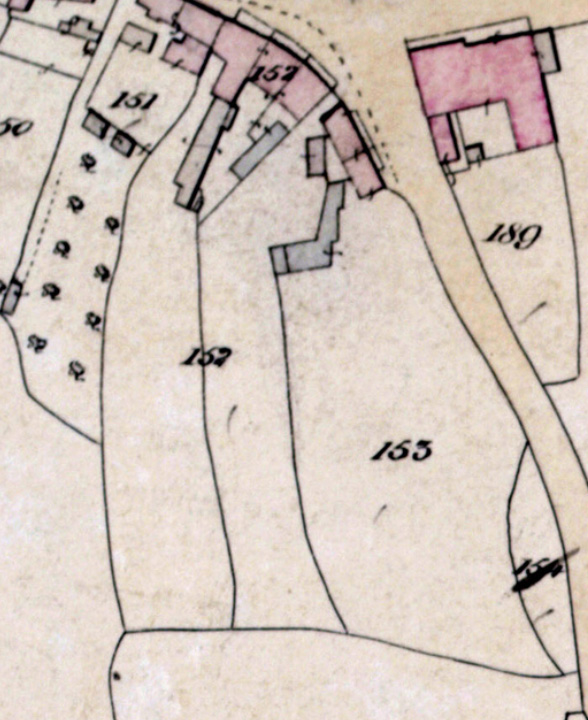 |
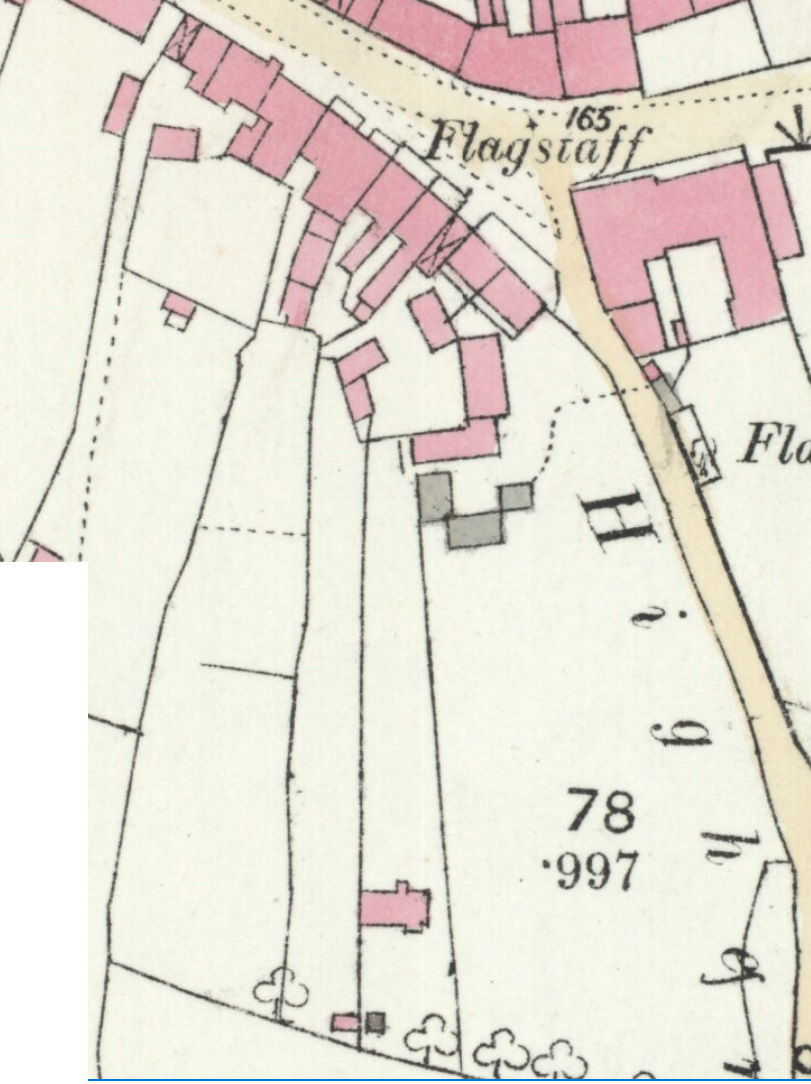 |
| 1841 Tithe Map showing Lot 152 with three adjoining houses and long garden behind them |
1887 Ordnance Survey Map |
|
William Greys Will 1762
I William Grey late of Lime house in Middlesex, but now of Charmouth, in the county of Dorset, Gentleman, do make this my last Will. After the death of my wife all my messuages, Tenements, Several Closes of Land and heridiaments situated and lying within the parish of Charmouth to my eldest son, Bennett Gray. My other four children will forsake their rights to this estate. My freehold messuages in Ropemakers fields in parish of St. Ann, Limehouse to my son Bennett Gray. My messuages and lands in parish of Clapton in Suffolk to my son William Gray. Messuages called Debathe in parish of Clapton to my three daughters, Elizabeth, the wife of William Fellows, mary and Susannah Gray. A thousand pound South Sea Annuity divided for daughters. Give unto my grandson William Fellows the sum of fifty pounds.
In the presence of John Sykes, Joseph White, Mary Dare.
Will was proved in 1762 by the oath of Mary Gray, wife of deceased |
|
Bennett Gray Will London 1823
I Bennett Gray, citizen and haberdasher of London. I give to my dear mother, Mary Gray all my real estates and ship for her natural life dispose of my parts of the ship Porpus. All my real and personal estate to be divided among my well beloved sisters, Elizabeth Fellows, Mary Aust and Susannah Gray.. that is to say my yearly rents and profits of my estate in Charmouth and the house in Limehouse. The estate situate in Kingston in Jamaica to be disposed of and divided equally with my sisters.
On 5th March 1823; Bennett Gray, formerly of Charmouth and late of Honduras in the West Indies but at sea deceased was granted to Harry Smith the sole Executor of the Will of Mary Aust, widow deceased .. Elizabeth Fellows, Mary Aust and Susannah Smith Widow the sisters |
|
| This Mary Aust`s Will of 1822 She was living in Mile End in Essex and left her estate to her nephew , Harry Smith. The descent of the estate goes through the Smith family to Bennett Fellows who also lives in Essex. |
|
This is the last Will of me Bennett Fellows R.N. August 1842
I give to my sister Elizabeth Fellows all my property of every description for her life at the death of my sister Elizabeth Fellows to my niece Mary Baker for her life at her death give the leasehold property in the parish of Romford now let to Mr Brewer of Romford to Mr Russell's children of Kingston Surrey at he death of my niece Mary Baker. I give to Mrs Margaret Smith now living with us the copyhold house and premises in the parish of Leyton in the county of Essex for her life the property in the village of Charmouth in the cont of Dorset. I leave to her and at her disposal to whom she may please. This property has been in the family several ages.I request and hope Mrs Smith will at he death leave all to one person. Subject to an annuity of £20 per Ann, to Mrs Ann Jenkins now living with m sister in Layton in the conty of Essex. I would wish I had more to leave her at the house and premises in Layton at the death of Mrs Smith I give to Mr Alfred Jones of Size Lane London, solicitor subject to a annuity of £10 per annum to Mrs Ann Jenkins now living with my sister Elizabeth Fellows at Layton died 1844 |
| |
|
1841 Census has Susannah Wellch aged 45 of Independent Means with daughters Eliza,Susanna ans Martha |
|
1851 Census showing Susanna Welch, Widow aged 55 living at the House |
|
1871Census has Dr. Joseph Symes living at Knap House with his wife Emily |
|
04 October 1866 - Dorset County Chronicle |
|
| The remainder of the estate at Beaminster eventually went to Joseph Symes of Charmouth, the younger son, who then owned Horsehill Farm, other lands in Stoke Abbott, Broadwindsor and Mosterton (Dibberford). He died in 1878 and his widow bequeathed Horsehill to her nephew Thomas Palmer Daniel the younger who sold the estate in the early 20th century for about £3007. |
|
16 July 1861 - Sherborne Mercury |
 |
| 1891 Census |
|
1901 Census shows Julia Claytor aged 39 at Knap House with her daughters, Mary and Violet. |
|
| 1901 Census Reference Book shows Mr Bridgeman - Beauregard, Lart - Author, Seaward - Labourer, John Lock - Laborer, Ruebarn Durrant - Foxley Farm (Darby Farm), Miss Willis - Melbourne House. |
 |
1911 Census for Knapp House with Charles Edward Lart as the head of the family
He wrote :
The parochial registers of Saint Germain-en-Laye : Jacobite extracts of births, marriages, and deaths; 1910 Volumes 1 and 2.
Registers of the French churches of Bristol, Stonehouse, and Plymouth [Reprint] Volume: 20 (1912)
Huguenot Pedigrees. Vol. I and II.
The Registers of the Protestant Church at Caen (Normandy): Vol. I and II (1907) and many other books.
Charles Edmund Lart - Naval Officer 1867 - 1947. There is a Manuscript Collection of French Hugenots
|
Reference in Cambridge Alumin to Charles Lart:
E entered CORPUS CHRISTI, Oct. 1, 1886. Of London. S. of Edmund, Esq., of 22, Norland Square, Notting Hill. B. Mar. 17, 1867, at 29, St James Square, Notting Hill. School, Westminster. Matric. Michs. 1886; B.A. 1889. 2nd Lieut., 1st Cinque Ports Vol. Art., 1900. Served in the Great War, 1914-19 (Capt., Devon Regt. (T.F.); Officer-Instructor attached to N.Z. Forces, 1916-17). Author, The Church Invisible, etc. Editor of the Publications of the Huguenot Society of London. Died June 29, 1947. (Record of Old Westminsters; Univ. War List; Army Lists.) |
|
NEWTON POPPLEFORD WAR MEMORIAL World War 1 & 2 - Detailed information
Compiled and copyright © John Hagger 2014
Wing Commander Edmund Lart (Pilot) 05102, 82 Squadron, Royal Air Force. Died 13 August 1940. Aged 39. Son of Charles Edmund and Amy Vincent Lart. His brother John Floyer Vincent Lart also fell. Awarded the Distinguished Service order (DSO). Buried in VADUM CEMETERY, Denmark. Collective Grave C.
In 1939 Edward Lart’s parents lived in Harpford, specifically in a house called “Navarah”. His father had served in the 1st World war in the R.A.M.C. and had attained the rank of Captain. Marian Wheeler (nee Radford), currently living in Newton Poppleford, was in service to the Lart family when she was a young girl. She has provided detailed information for this story. Edward’s father was Dr Charles Edmund Lart M.B. and his mother was Amy Vincent Lart (maybe her maiden name was Vincent).They had two daughters and three sons. Edward was the oldest son and second child.. Born 1902, John Lart was the middle son. (See below). At the time most of the children were born, the family lived at Knapp Cottage, Lyme Regis. By 1911 Dr Charles Lart appears to have retired. The youngest son was probably too young to serve in WW2 and was (in 2013) living in the Midlands. He also had followed his father, into becoming a medical doctor. The two daughters were called Joanna and Judith.
Edward Lart joined the, relatively small, Royal Air Force in the years between the wars, and had risen from Pilot Officer to Wing Commander by 1940. Wing Co. Edward Lart D S O, Commanded 82 Squadron at R A F Watton. He seems to have been awarded the D.S.O. “For meritorious service”
On August 13th 1940 he led a formation of 12 Blenhiem Mark IV’s on a raid on an airfield in Denmark called Aalborg that was being used by the Luftwaffe to raid the northern towns of England. Why did he lead this operation? C.O.’s & Wing Commanders rarely go on “op’s” any more than generals often stand in trenches. It may have been the most disastrous mission for R A F. Bomber Command, in the 2nd World War, and Edward Lart probably foresaw this. Blenhiems were sitting ducks for the Luftwaffe. Of the 12 aircraft that took off, 11 were shot down. Even more sadly the captain of the one surviving aircraft was court marshalled for “dereliction of duty and cowardice in the face of the enemy”. He did not face the charge, as he was killed on a subsequent operation before the case was heard.
19 airmen were killed and 13 wounded and captured. Wing Commander Lart was shot down and killed at 12.23 on 13th Aug over Aalborg, just 2 months after he had been promoted to Wing Commander. Maybe he knew that few, if any would survive, and preferred to face death with his men. The Mark IV Blenhiem was not a successfully designed aircraft and was known to be no match for the Luftwaffe fighter aircraft. Because of the distance involved, they could not be given any fighter cover. The few Blenhiems that remained, were withdrawn from service by 1942. In 1943 Lincoln’s and Lancaster’s became the main bomber aircraft for the RAF, both were very successful aircraft, the Lancaster continuing in service until 1954.
Edward Lart aged 38, is buried in ‘a collective grave’ in Vadum Cemetery in Denmark. He is remembered in the record of all those from RAF Watton who died in the service of their country and on the Newton Poppleford Village War memorial.
Captain 231988, Royal Army Medical Corps. Died 5 January 1944. Aged 40. Son of Charles Edmund and Amy Vincent Lart. M.B. Buried in CASSINO WAR CEMETERY, Italy. Plot VII. Row F. Grave 18.
John Floyer Vincent Lart was the younger brother of Edward Lart (see above). Born 1904 he had followed in the steps of his father and become a medical doctor. His father Charles Edmund Lart had served in the first world war in The Royal Army Medical Corp and attained the rank of Captain. John also joined the RAMC. In Army terms he was quite senior in years and rose to the rank of Captain. His brother Edward had died only months into WW2 so his parents, two sisters and brother, must have spent all the main years of the war fearing that they would have to suffer the same loss as they had with Edward. By the bleak Christmas of 1943 however a probable end to the conflict was at least in sight. Italy had capitulated and Germany saw that it had to defend three fronts from attack, from the West (France), the East (Russia) and from the south, as the Allies had successfully landed in Sicily and moved up the length of Italy.
After the difficulties of the Sicily landings, the advance into Italy was slow but remorseless. The Germans had decided to defend Rome and northern Italy at Monte Cassino. They erected defence lines at the approaches to Cassino called ”The Winter Line“, and “ The Gustav Line “.that included the Monastery which is on a prominent hill top.
Field hospitals were not usually set up too close to points of conflict, particularly when an army is advancing, however it would seem that John Lart’s hospital was either hit by artillery fire or he was killed in some other event. Medical forces are non- combatants, in accordance with The Geneva Convention. Sadly he was killed on 5th Jan 1944 in the approaches of Monte Cassino.
Captain (and doctor) John Floyer Vincent Lart No. 231988 is buried in the The Cassino War Cemetery, in Grave V11.F.18. He was aged 39. He name appears on the St Thomas’s Hospital (London) War memorial, and on the village memorial in Newton Poppleford. |
|
1901 Ordnance Survey Map |
| Claud Hider of Bridport produced a set of extremely rare postcards for the owners of Claremont, no doubt to promote their Guest House. They were probably taken c.1923, when he produced a number of postcards of the village in that year. |
|
Claremomt House in 1923 when it was a Boarding House run by Hodges |
|
The same view today |
|
| |
|
| |
|
| |
|
| |
|
| |
|
| |
|
| |
|
| Aug. 2, at 13, Seymour Plac e, Fulham Road, London, Mrs. Fowler, late of the Knapp. Charmouth, Dorset.13 August 1881 - Southern Times and Dorset County Herald - Weymouth, Dorset. |
|
| At liberty for Pantomime . Address as above . and Eccentric Comedy . MR . H . Mant WORSLEY , of the Wight, Disengaged . The Knapp House , Charmouth , Dorset. 25 September 1885 - The Stage - London, London, England |
|
| Charmouth, Dorset. - To be Let, furnished for summer months, a House containing dining and drawing rooms, five bed-rooms, includiug two attics, with lovely view or hills and sea ; use of piano and lmen. — Address Mrs. H., The Knapp. Charmouth. Dorset01 July 1885 - London Evening Standard - London, |
|
| Clarke.—June 15, at his residence, Knapp House, Charmouth, Mr Frederick Christian Clarke, late of Chapelstreet, Bedford Row, London, in his 83rd yard. 02 July 1890 - Taunton Courier, and Western Advertiser - Taunton, Somerset, |
|
WANTED, good-tempered willing GIRL (good character), good plain cooking required ; small family.—Apply to Mrs Clarke, Knapps House, Charmouth,13 May 1892 - Bridport News - Bridport, Dorset, England |
|
| COOK-GENERAL and HOUSE-PARLOURMAID (experienced) Wanted early October. Small guesthouse.—Apply Littlebury, Claremont, Charmouth, Bridport.0 September 1929 - Western Gazette - Yeovil, Somerset, England |
| Some help given. Experienced, good plain cooking, good personal references essential.—Reply Mrs. Read, Claremont, Charmouth.19 May 1933 - Western Gazette - Yeovil, Somerset, England |
|
| |
|
| |
|
| |
House of Commons Report on Proposed Turn Pike Road:
"Askerswell Hill (Devon a27 Geo II Parl 4 Sess 7; A 1753-54) Part of road from Charmouth Bridge to the top of Charmouth hill is so steep, rocky narrow and of so great a height that the same is very dangerous and that the said hill may easily be avoided by making a road under the NW side.hat road to top of Charmouth hill which leads from Bridport to Charmouth Bridge is very inconvenient and dangerous and needs to turn the road to the NW, to make more commodious, which may be done without difficultyThat the road from the Almshouse at Charmouth to and thru Lyme Regis and to and thru Uplyme and over Uplyme Hill to the direction stone on the road to Axminster is not intended to be repaired by tolls arising although said road is the ancient post road and is now and for many years has been the post road from Salisbury to Axminster and when repaired will be very commodious to travellers".
In 1757, there is a description of the existing road as that “ High Road leading from the Almshouse at west end of Charmouth to and thru Lyme Regis which are in a ruinous condition, narrow in many places and very steep and uneven and by reason of the waters in the winter season unpassable at divers places and very dangerous to travellers cannot be repaired, widened by present methods” As a result, the following year Charmouth had the first of its turnpike roads built. It was known as the Great Western Road and continued on as far as Aylesbeare, within a few miles of Exeter . It started from the top of the Street where there would have been a toll gate which were generally stout and substantial with keeper as depicted here. A turnpike was a gate set across a new or improved road which was only opened when a toll had been paid to the turnpike-keeper. During the day they may have been left open, or at least ajar, on a busy road but at night were closed and the pikeman would need rousing to take the toll (or, heralded by a coach horn, let the mail coach through free of toll). This individual lived in a tollhouse, which often had windows facing in both directions so that the keeper could see the traffic approaching from either side. |
|
| |
|
| |
|
| Evidence of the gate which would have gone across the street was found by workman laying drains in the form of the stump and the post hole of part of it. In 1939 the other Stump was found on the opposite side. The original Gate was demolished shortly after 1874. |
|
| Here are the workmen busy at the time. The buildings in the background are Waterloo House( now the fossil shop) and Granville House which at that time was a shoemakers owned by the Hutchin. |

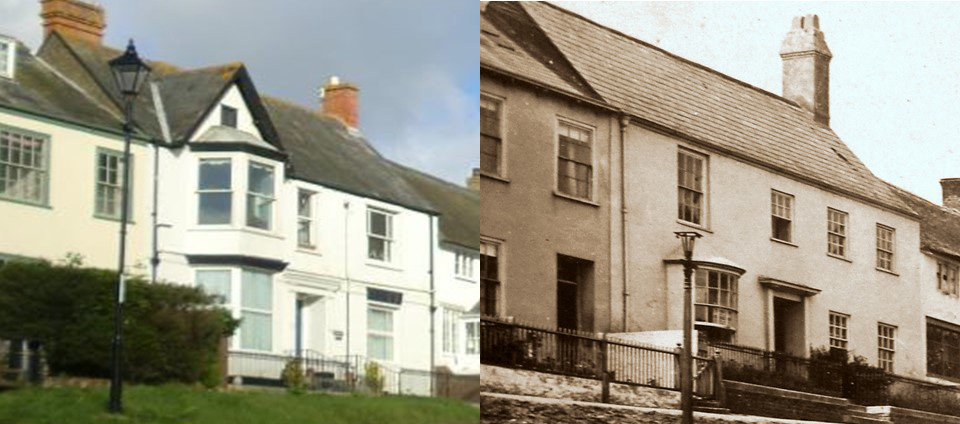
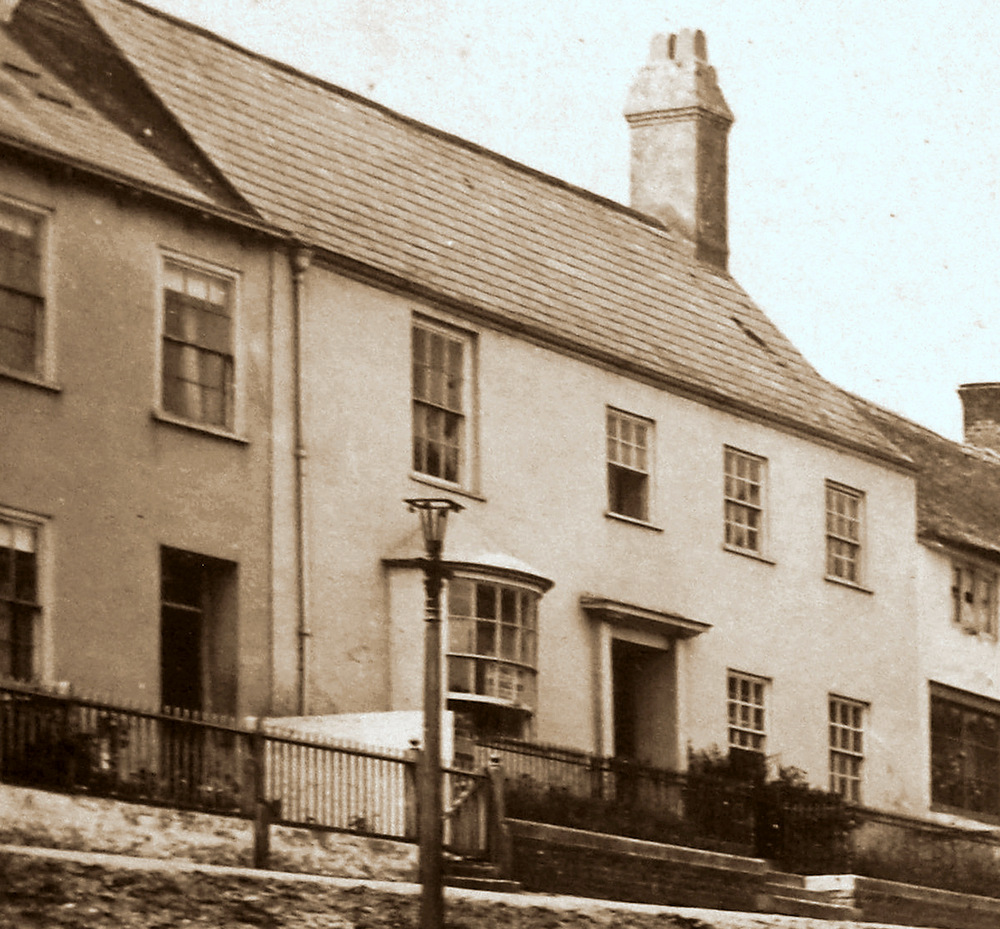
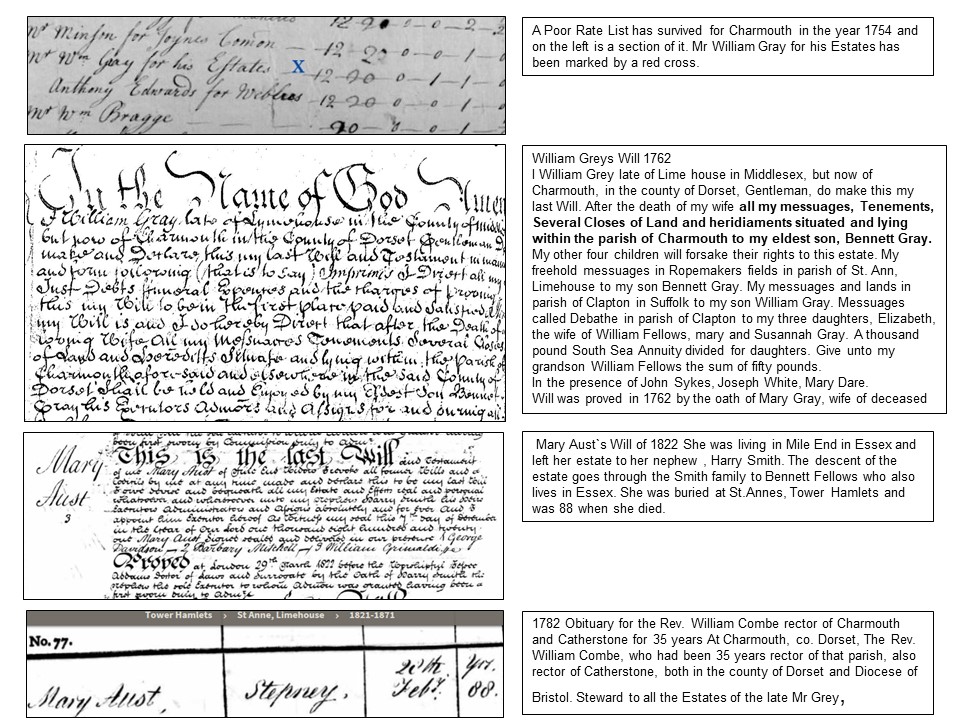
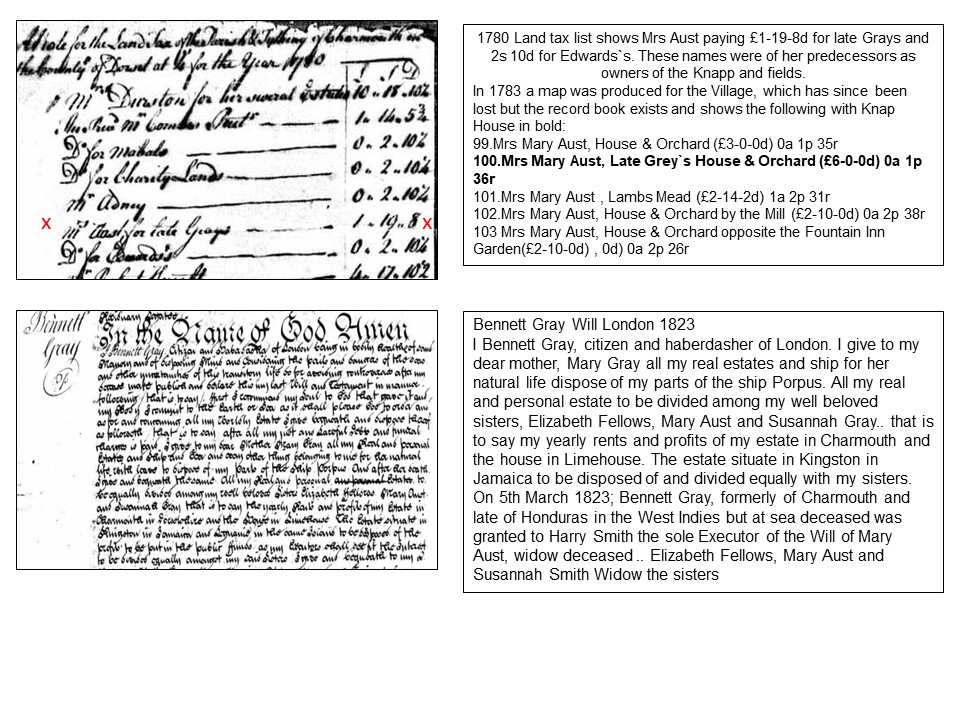
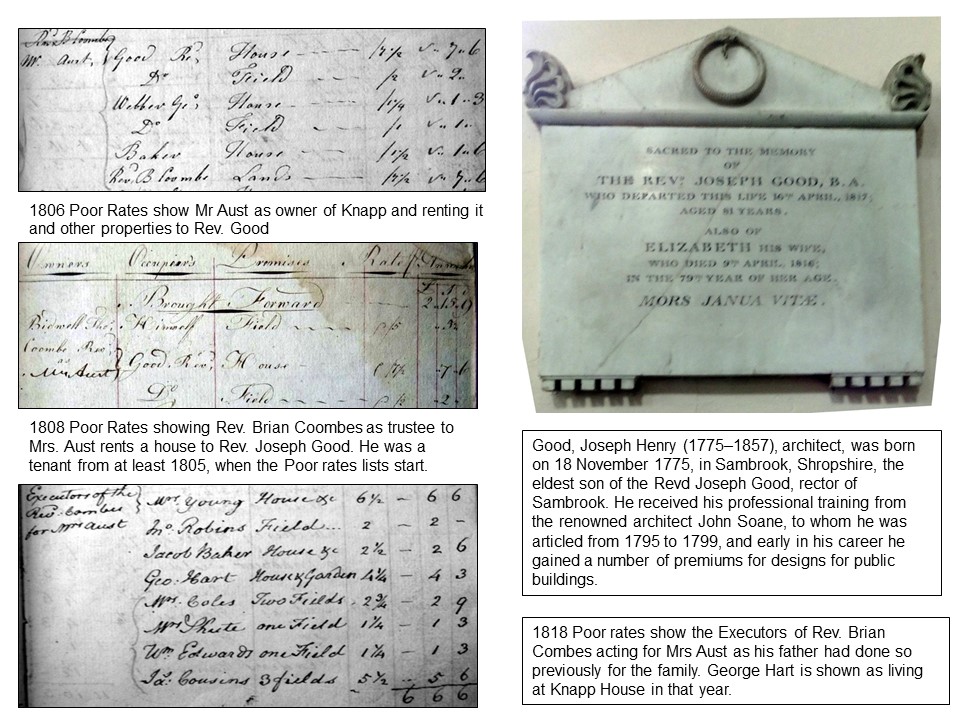

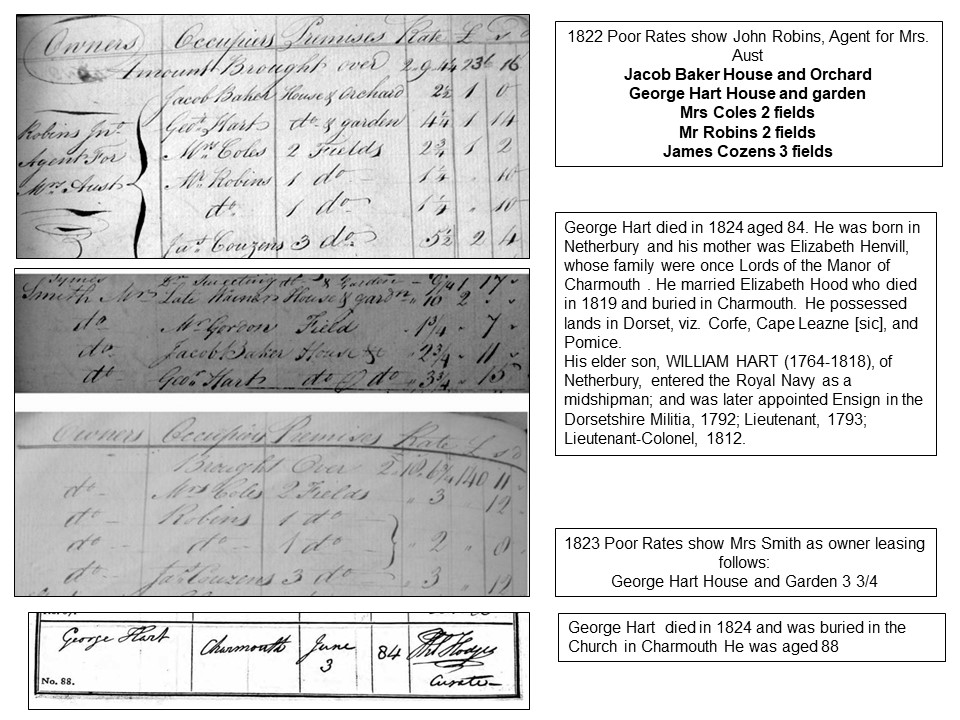
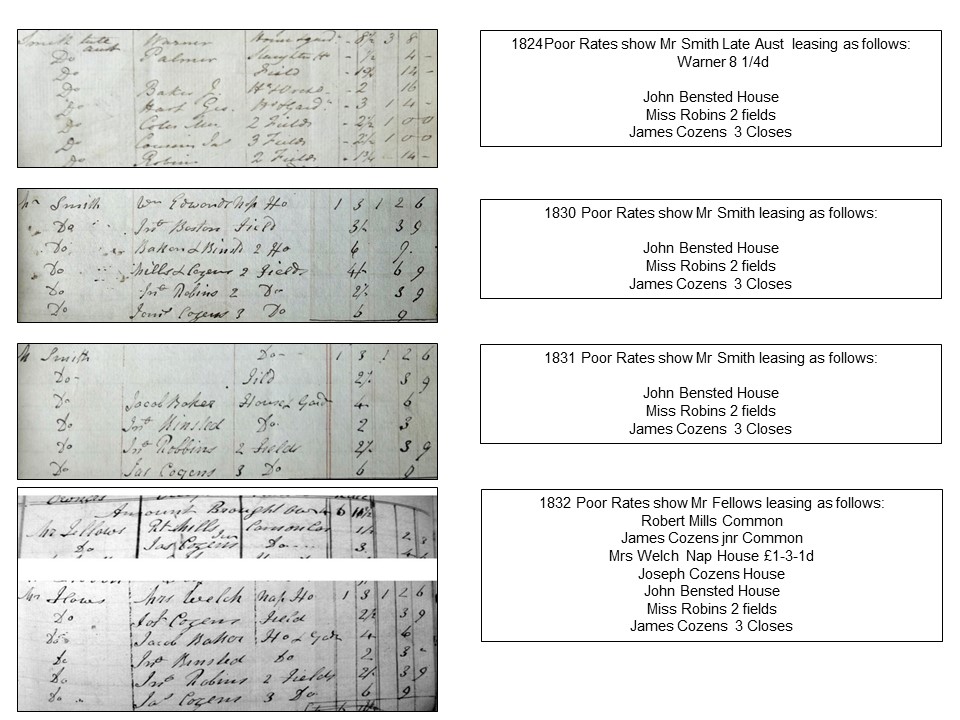


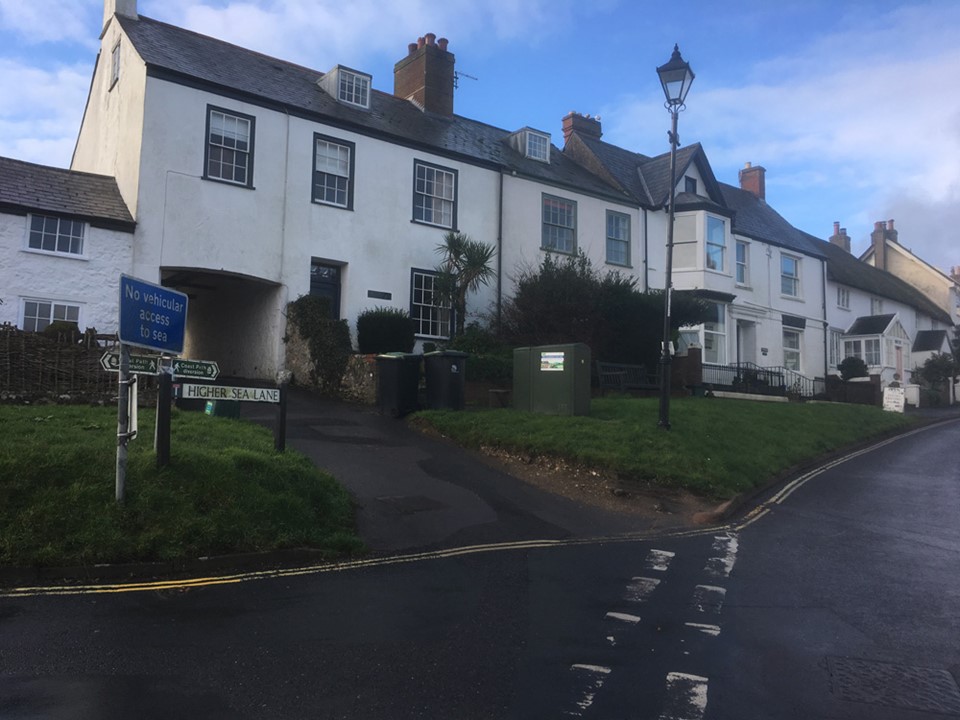





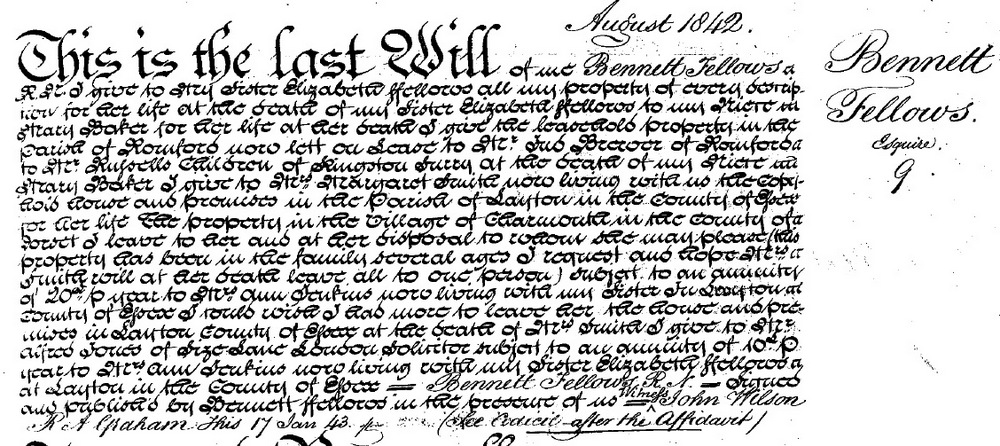

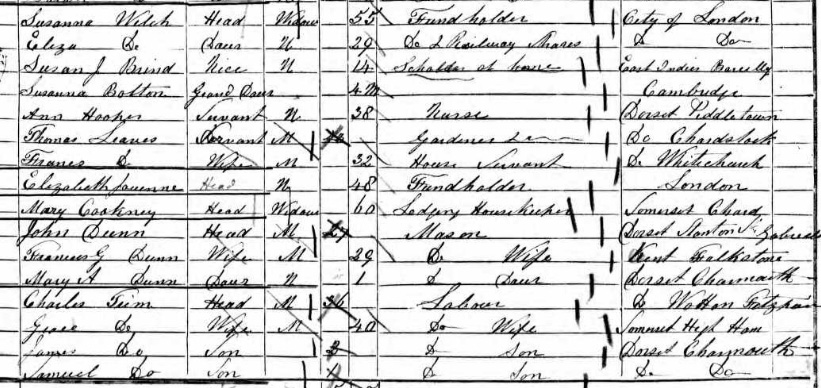


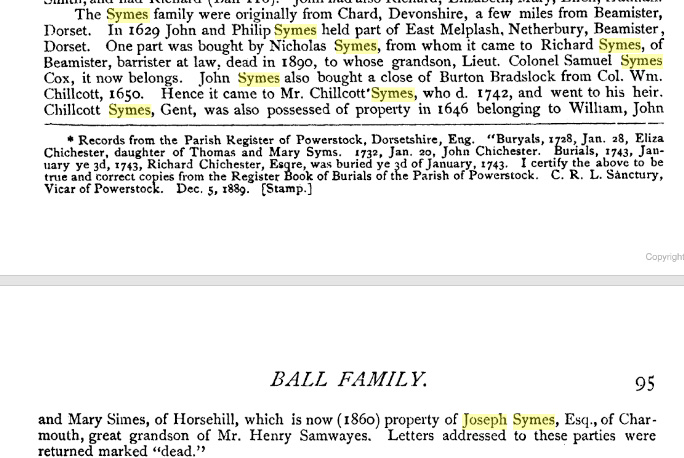





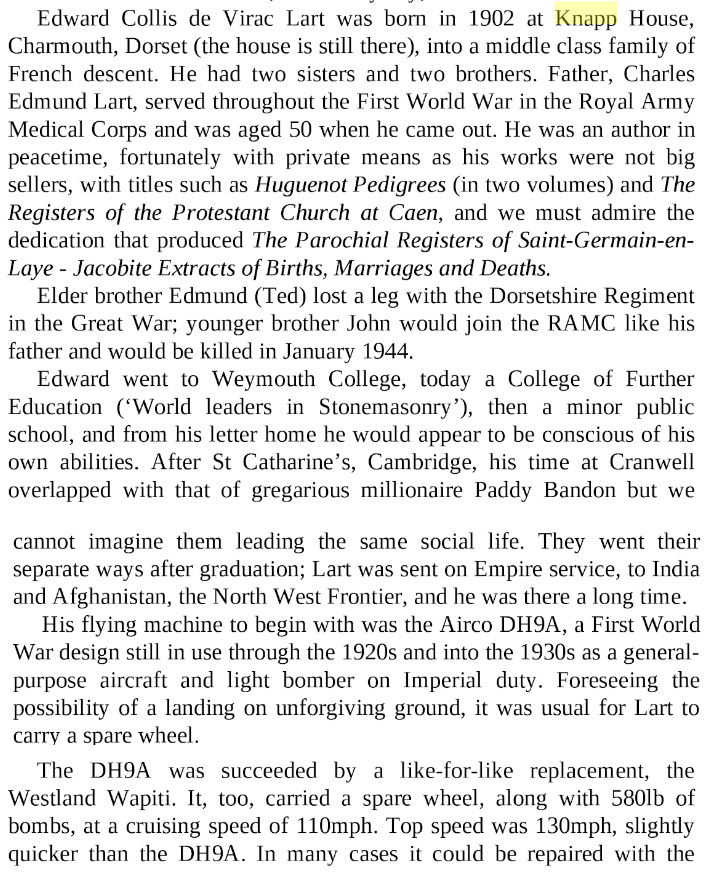
.jpg)
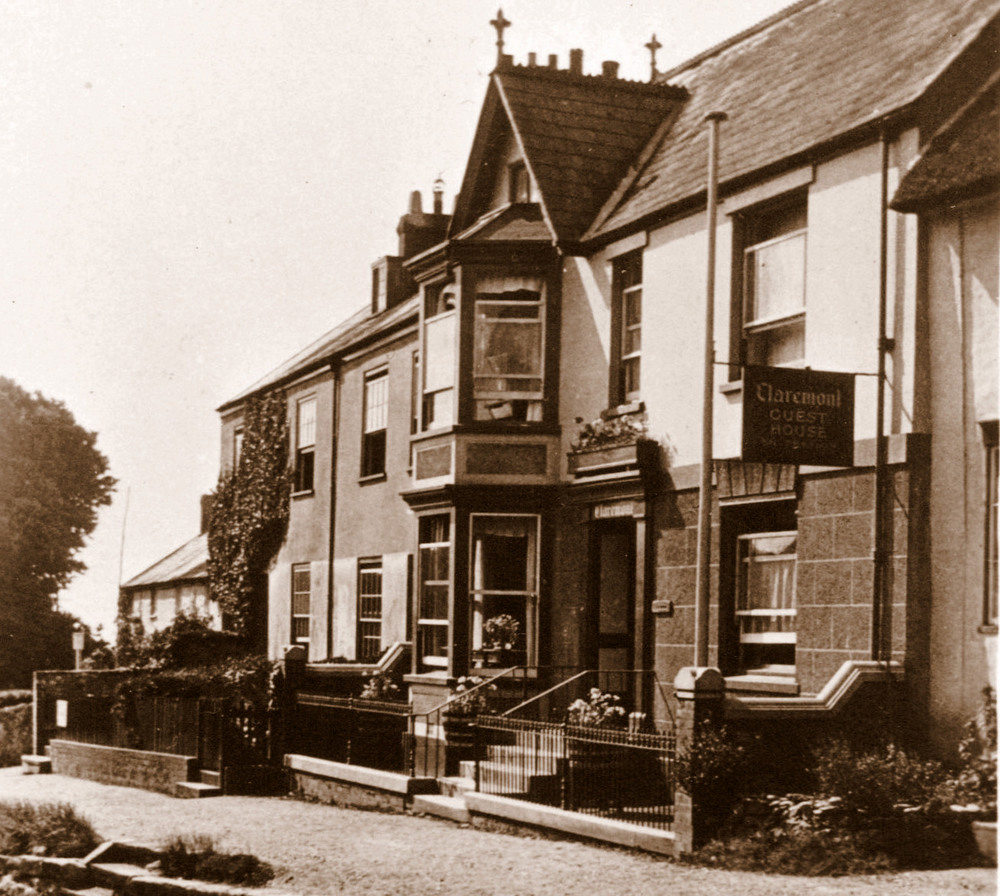

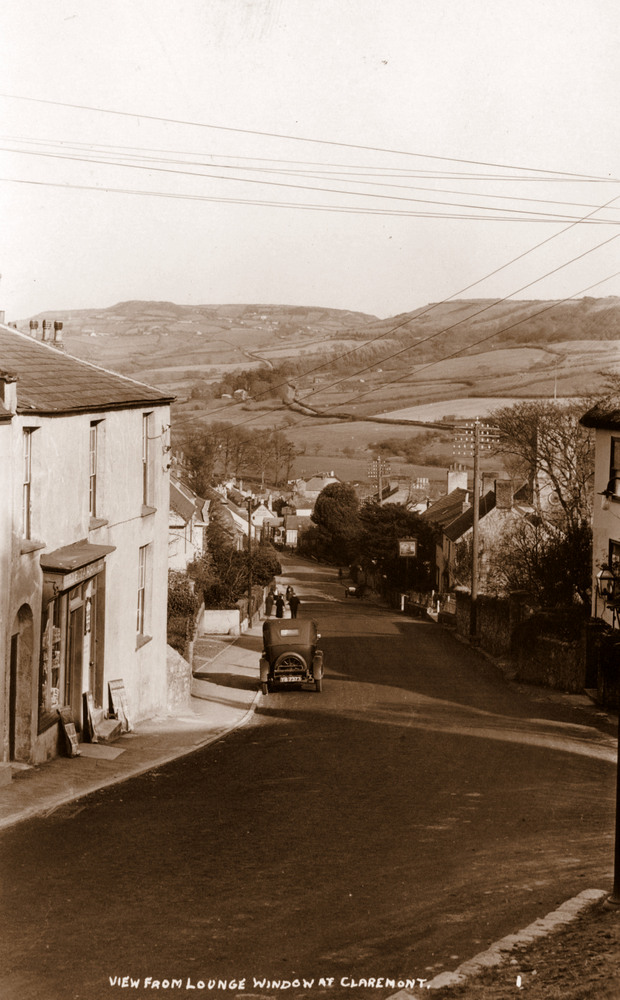

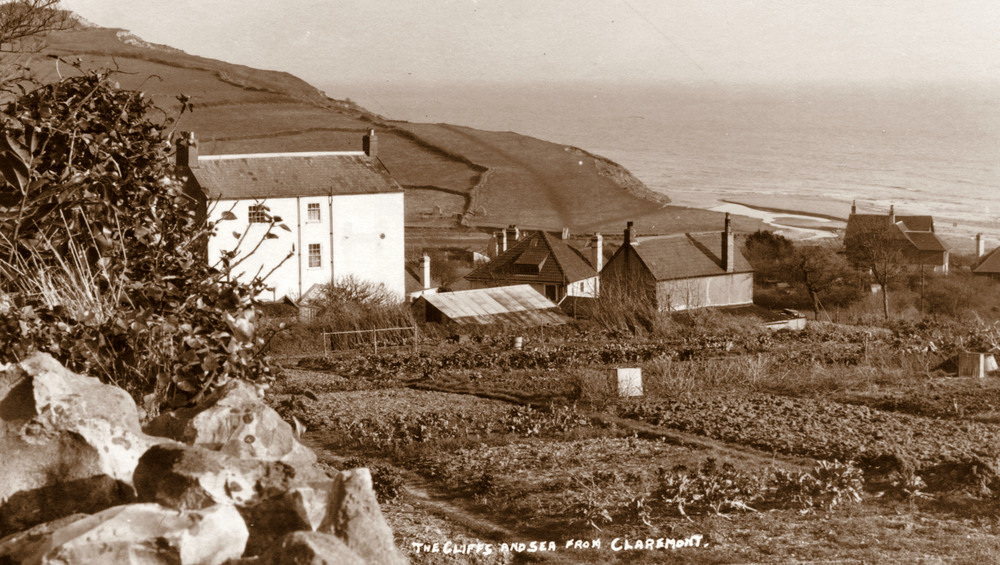
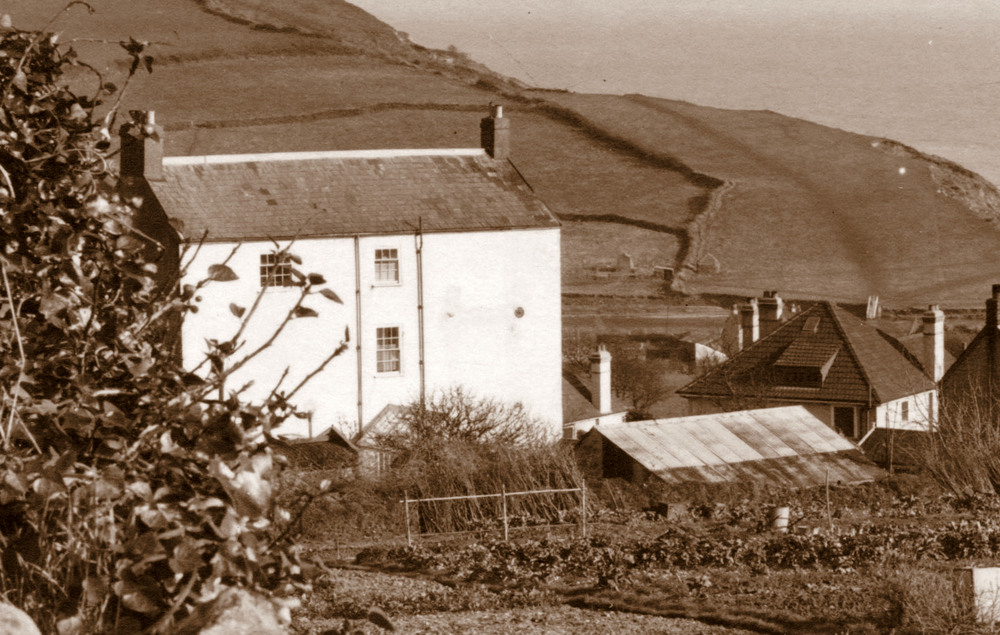
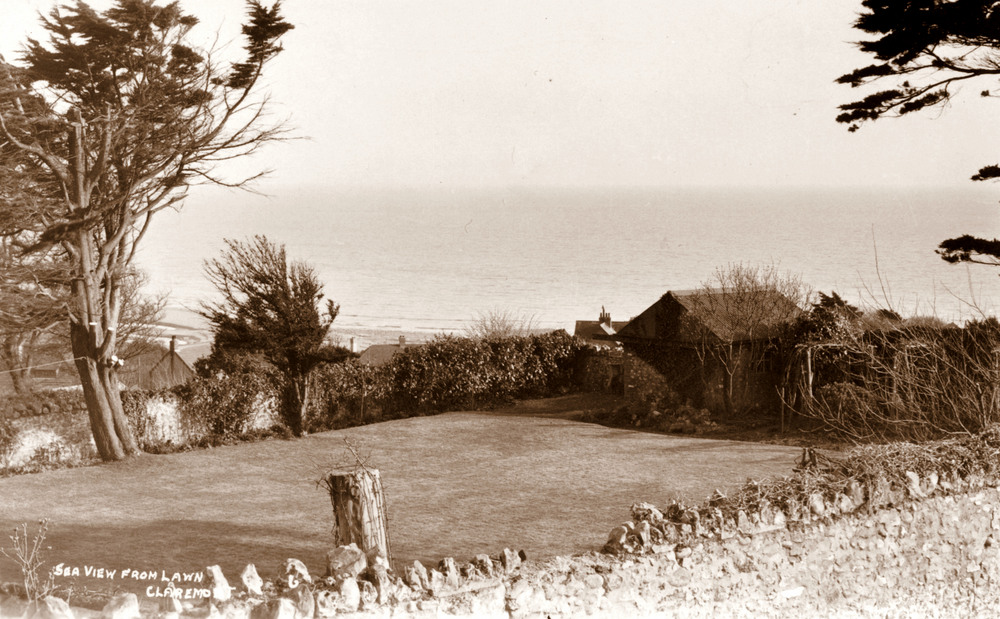
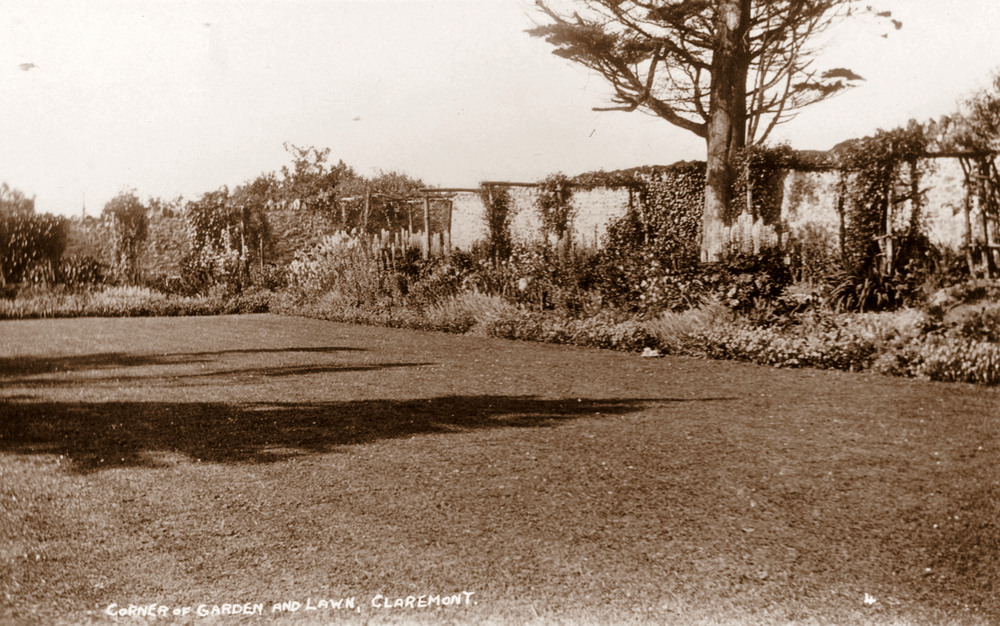
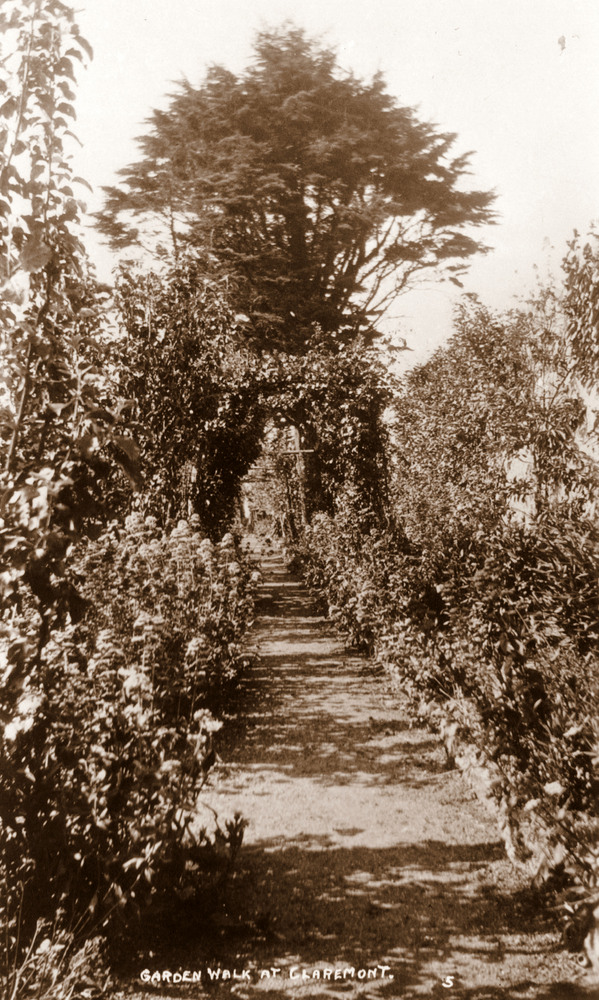







.jpg)
